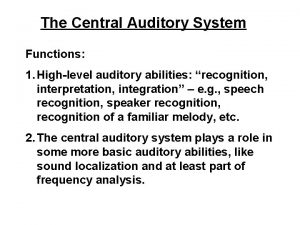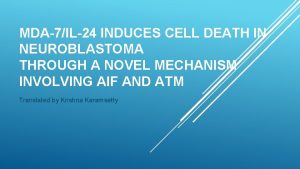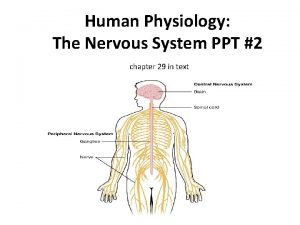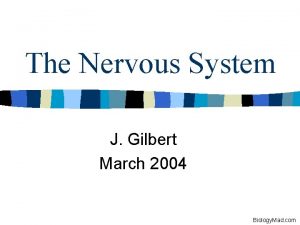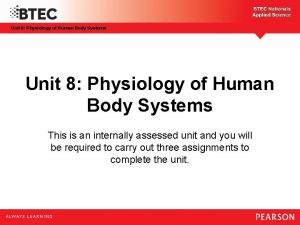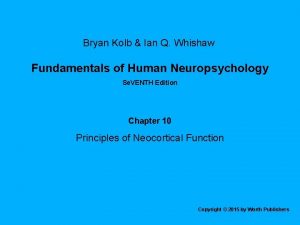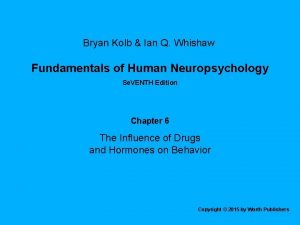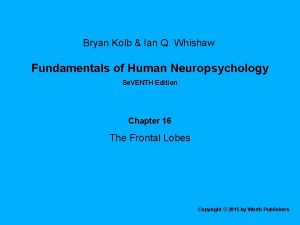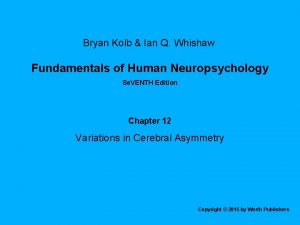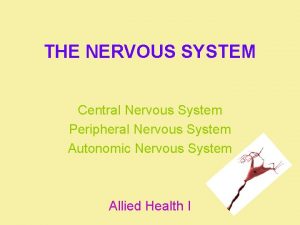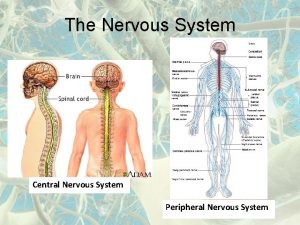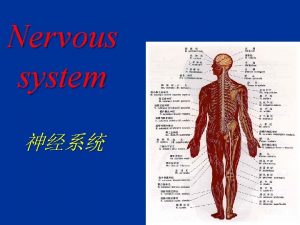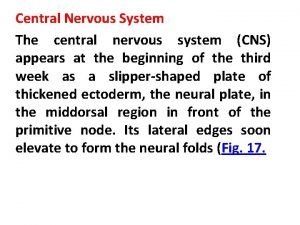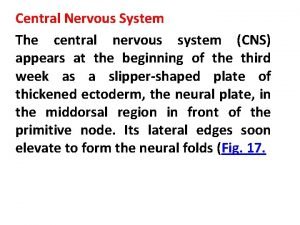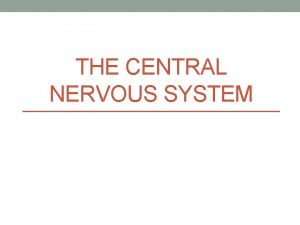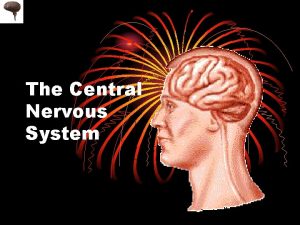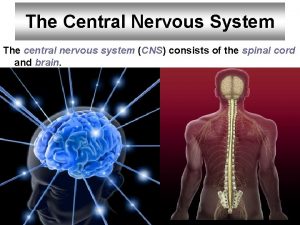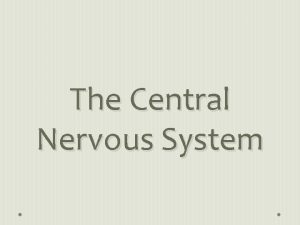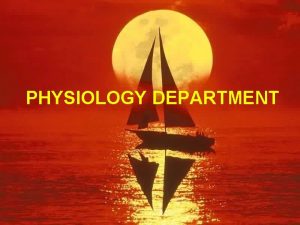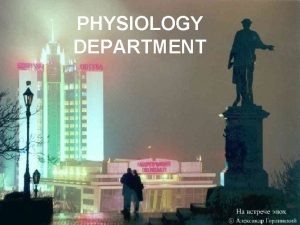HUMAN PHYSIOLOGY Nervous System Fundamentals Central Nervous System































- Slides: 31

HUMAN PHYSIOLOGY Nervous System Fundamentals Central Nervous System

Central Nervous System (CNS) � � CNS consists of the brain and spinal cord Cephalization � Evolutionary development of a head and CNS � Increased number of neurons in the head � Highest level is reached in the human brain

Regions and Organization of the CNS Adult brain regions � 1. 2. 3. 4. Cerebral hemispheres Diencephalon Brain stem (midbrain, pons, and medulla) Cerebellum

Regions and Organization of the CNS � Spinal cord � Central cavity of gray matter core � External white matter composed of myelinated fiber tracts

Cerebral Cortex � � � Thin (2– 4 mm) superficial layer of gray matter 40% of the mass of the brain Site of conscious mind: awareness, sensory perception, voluntary motor initiation, communication, memory storage, understanding Each hemisphere connects to contralateral side of the body There is lateralization of cortical function in the hemispheres

Motor Areas � � Primary (somatic) motor cortex � Frontal lobe � Consciously control precise/skilled movements � Spatial representation Premotor cortex � Learned motor skills (repetitions, patterns) � Planned movement Broca’s area � Usually only in one hemisphere � Motor speech area (thinking, planning, and performing) Frontal eye field � Voluntary eye movement

� � � � Sensory Areas Primary somatosensory cortex Somatosensory association cortex Visual areas Auditory areas Olfactory cortex Gustatory cortex Visceral sensory area Vestibular cortex

Functions of the Nervous System 1. Sensory input � 2. Integration � 3. Information gathered by sensory receptors about internal and external changes Interpretation of sensory input Motor output � Activation of effector organs (muscles and glands) produces a response

Divisions of the Nervous System � Central nervous system (CNS) � Brain and spinal cord � Integration and command center � Peripheral nervous system (PNS) � Paired spinal and cranial nerves carry messages to and from the CNS

Peripheral Nervous System (PNS) Two functional divisions � Sensory (afferent) division 1. Somatic afferent fibers—convey impulses from skin, skeletal muscles, and joints Visceral afferent fibers—convey impulses from visceral organs Motor (efferent) division 2. Transmits impulses from the CNS to effector organs

Motor Division of PNS 1. Somatic (voluntary) nervous system � 2. Conscious control of skeletal muscles Autonomic (involuntary) nervous system (ANS) Visceral motor nerve fibers � Regulates smooth muscle, cardiac muscle, and glands � Two functional subdivisions Sympathetic Parasympathetic �

Histology of Nervous Tissue � Two principal cell types 1. Neurons—excitable cells that transmit electrical signals

Histology of Nervous Tissue 2. Neuroglia (glial cells)—supporting cells: Astrocytes (CNS) Microglia (CNS) Ependymal cells (CNS) Oligodendrocytes (CNS) Satellite cells (PNS) Schwann cells (PNS)

Neurons (Nerve Cells) � Special characteristics: � Long-lived ( 100 years or more) � Amitotic—with few exceptions � High metabolic rate—depends on continuous supply of oxygen and glucose � Plasma membrane functions in: Electrical signaling Cell-to-cell interactions during development

Dendrites � � � Short, tapering, and diffusely branched Receptive (input) region of a neuron Convey electrical signals toward the cell body as graded potentials

The Axon � � � One axon per cell arising from the axon hillock Long axons (nerve fibers) Occasional branches (axon collaterals) Numerous terminal branches (telodendria) Knoblike axon terminals (synaptic knobs or boutons) � Secretory region of neuron � Release neurotransmitters to excite or inhibit other cells Telodendria Axon terminals

Resting Membrane Potential � Differences in ionic makeup � Inside the neuron has lower concentration of Na+ and Cl– than outside � Inside has higher concentration of K+ and negatively charged proteins (A–) than outside

Resting Membrane Potential � � Negative interior of the cell is due to much greater diffusion of K+ out of the cell than Na+ diffusion into the cell Sodium-potassium pump stabilizes the resting membrane potential by maintaining the concentration gradients for Na+ and K+

Membrane Potentials That Act as Signals � Membrane potential changes when: � Ion concentrations on two sides change � Permeability of membrane to ions changes � Changes in membrane potential are signals used to receive, integrate and send information

Changes in Membrane Potential � Depolarization �A reduction in membrane potential (toward zero) � Inside of the membrane becomes less negative than the resting potential � Increases the probability of producing a nerve impulse � Hyperpolarization � An increase in membrane potential (away from zero) � Inside of the membrane becomes more negative than the resting potential � Reduces the probability of producing a nerve impulse

Membrane Potentials That Act as Signals � Two types of signals �Graded potentials Incoming short-distance signals �Action potentials Long-distance signals of axons

Graded Potentials vs. Action Potentials GRADED POTENTIAL � � � Chemically gated ion channels Stimulus is related to the strength Die out with increasing distance � � ACTION POTENTIAL � � Due to leakage of the charge Short distance travel � Voltage gated ion channels Stimulus is consistent Do not decrease with distance Long distance travel Graded Potentials can cause Action Potentials

The Synapse � A junction that mediates information transfer from one neuron: � To another neuron, or � To an effector cell � � Presynaptic neuron—conducts impulses toward the synapse Postsynaptic neuron—transmits impulses away from the synapse

Chemical Synapses � � Specialized for the release and reception of neurotransmitters Typically composed of two parts � Axon terminal of the presynaptic neuron � Receptor region on the postsynaptic neuron

Information Transfer 1. 2. 3. 4. 5. AP arrives at axon terminal of the presynaptic neuron and opens voltage-gated Ca 2+ channels Voltage gated Ca 2+ channels open and Ca 2+ enter the axon terminal Exocytosis of neurotransmitter occurs Neurotransmitter diffuses and binds to receptors on the postsynaptic neuron Ion channels are opened, causing an excitatory or inhibitory event (graded potential)

Multimodal Association Areas � Receive inputs from and sends outputs to multiple sources � Give meaning to information received � Store it as memory � compare it to previous experience, and action to take � � decide on Area where sensations, thoughts, and emotions become conscious Three parts � Anterior association area (prefrontal � Posterior association area � Limbic association area cortex)

Diencephalon � Three paired structures � Thalamus � Hypothalamus � Epithalamus � Encloses the third ventricle

Brain Stem � Three regions � Midbrain � Pons � Medulla oblongata

The Cerebellum � � � 11% of brain mass Dorsal to the pons and medulla Subconsciously provides precise timing and appropriate patterns of skeletal muscle contraction

Protection of the Brain � � Bone (skull) Membranes (meninges) Watery cushion (cerebrospinal fluid) Blood-brain barrier

Spinal Cord � Location � Begins at the foramen magnum � Ends as conus medullaris at L 1 vertebra � Functions � Provides two-way communication to and from the brain � Contains spinal reflex centers
 What are the characteristics of nervous tissue
What are the characteristics of nervous tissue Sensory input and motor output
Sensory input and motor output Neuron processes
Neuron processes Major divisions
Major divisions Central nervous system amusement park
Central nervous system amusement park Cns
Cns Nervous system vocabulary
Nervous system vocabulary Nervous system of grasshopper
Nervous system of grasshopper Central auditory nervous system
Central auditory nervous system Neuroglia
Neuroglia Central nervous system for kids
Central nervous system for kids Human nervous system ppt
Human nervous system ppt The human nervous system biology mad
The human nervous system biology mad Human anatomy and physiology seventh edition marieb
Human anatomy and physiology seventh edition marieb Waistline
Waistline Unit 8: physiology of human body systems
Unit 8: physiology of human body systems Anatomy and physiology exam 1
Anatomy and physiology exam 1 Holes essential of human anatomy and physiology
Holes essential of human anatomy and physiology Distal and proximal
Distal and proximal Chapter 2 human reproductive anatomy and physiology
Chapter 2 human reproductive anatomy and physiology Human anatomy and physiology 10th edition
Human anatomy and physiology 10th edition Human anatomy & physiology edition 9
Human anatomy & physiology edition 9 Central nervous sysytem
Central nervous sysytem Human performance fundamentals
Human performance fundamentals Maup kolb
Maup kolb Fundamentals of human neuropsychology
Fundamentals of human neuropsychology Fundamentals of human neuropsychology
Fundamentals of human neuropsychology Dr shane bush
Dr shane bush Human performance fundamentals
Human performance fundamentals Kolb whishaw
Kolb whishaw Nervous system and digestive system
Nervous system and digestive system Endocrine system vs nervous system
Endocrine system vs nervous system








